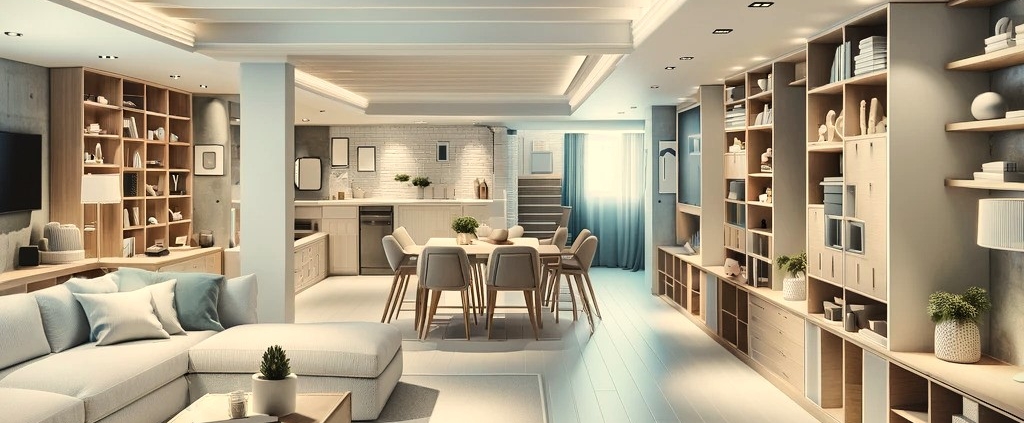The Basics of Basement Remodeling
If you’re feeling overwhelmed with the idea of basement remodeling, don’t worry! This guide will break down the basics for you. Let’s start with understanding what basement remodeling is, and why it might be a good idea for your home or business.
What Is Basement Remodeling
Basement remodeling is essentially a transformation process. It involves taking a basic, often underutilized or neglected basement, and turning it into a functional, comfortable, and aesthetically pleasing space. This process can include a variety of tasks, such as installing insulation, adding walls and flooring, improving lighting, and incorporating decorative elements.
The end result of a basement remodel can be a completely new room or set of rooms that serve a specific purpose. This could be anything from a home office, a playroom, a gym, or even a self-contained apartment. Each remodel is unique, tailored to your specific needs and preferences.
Why Consider a Basement Remodel
There are many reasons why you should consider a basement remodel. Here are a few key ones:
- Increased Living Space: One of the main reasons homeowners embark on a basement remodel is to increase their living space. This is particularly beneficial for growing families or those who work from home.
- Improved Home Value: A well-executed basement remodel can significantly increase the value of your home. This can be a major selling point if you ever decide to move.
- Additional Income: If you remodel your basement into a self-contained apartment, you could potentially rent it out for additional income.
- Customization: A basement remodel gives you the freedom to create a space that perfectly suits your needs, whether that’s a home gym, a dedicated workspace, or a cozy family room.
- Efficient Use of Space: Remodeling your basement is an excellent way to make use of what might otherwise be wasted space.
Remember, a successful basement remodel requires careful planning and execution. It’s not just about making the space look good, but also ensuring it’s functional, comfortable, and safe. For more information on how to get the most out of your basement remodel, check out our articles on basement renovation design and basement renovation ideas.
Planning Your Basement Remodel
The success of your basement remodeling project largely depends on the planning phase. By having a clear vision, a well-defined budget, and understanding the scope of your project, you can ensure a smooth renovation process. Let’s dive into each of these crucial planning steps.
Setting Your Goals
Before you swing that hammer, it’s important to define the goals for your basement remodel. Are you looking to create a cozy family room, a functional home office, or a fully equipped home gym? Your goals will guide your remodeling decisions and help you visualize the finished space.

Remember to consider your long-term needs and how the space could evolve over time. For instance, a playroom today could transition into a teen hangout or a guest room in the future. If you need inspiration, check out our article on basement renovation ideas.
Creating a Budget
Next up is budgeting. A clear budget will keep your basement remodeling project within financial boundaries. It’s important to account for costs associated with materials, labor, permits, and unexpected expenses that may arise.
Here’s a simple budgeting table to help you get started:
| Expense Category | Estimated Cost |
|---|---|
| Materials | $ |
| Labor | $ |
| Permits | $ |
| Contingency (10-20% of total) | $ |
| Total | $ |
Remember, the total cost of remodeling will depend on the scope and complexity of your project. For a more detailed breakdown on costs, visit our basement renovation cost guide.
Understanding the Scope of the Project
Finally, understanding the scope of your project is crucial. This involves identifying what work needs to be done, the order in which it will be carried out, and who will be responsible for each task.
Consider elements like structural changes, electrical and plumbing work, insulation, drywalling, painting, flooring, and fixture installation. You should also think about any special features you want to include, like a home theater system, a wet bar, or built-in shelving.
The scope of your project will impact your timeline, budget, and overall renovation experience. It’s always a good idea to consult with professionals to help you assess the project scope accurately.
By setting clear goals, creating a realistic budget, and understanding your project’s scope, you’re well on your way to a successful basement remodel. Happy planning!
Pre-Remodel Checklist
Before diving into your basement remodeling project, it’s essential to have a clear plan in place. This includes evaluating the condition of your basement, addressing any pre-existing issues, and obtaining any necessary permits. Here’s a closer look at each of these critical steps.
Evaluating Your Basement’s Condition
The first step in the remodeling process is to evaluate the current condition of your basement. You’ll need to inspect the space thoroughly to identify any potential problems or concerns. Pay special attention to any signs of water damage or leakage, as these can lead to significant issues down the line. Additionally, check for signs of mold, pests, or structural damage. These factors could impact the safety and success of your remodel.
Addressing Any Pre-existing Issues
Once you’ve evaluated the condition of your basement, the next step is to address any pre-existing issues. This might include repairing any water damage, treating mold growth, or addressing structural concerns. Remember, it’s always best to tackle these problems head-on rather than trying to cover them up during the remodel. Ignoring these issues could lead to more expensive repairs down the line and could potentially jeopardize the integrity of your entire basement renovation.

Obtaining Necessary Permits
Another crucial step in the pre-remodel process is obtaining any necessary permits. Depending on where you live and the scope of your project, you may need to obtain several permits before you can begin your basement remodel. This could include building permits, electrical permits, or plumbing permits. Make sure to check with your local city or county office to determine what permits you’ll need and how to obtain them. While this might seem like a hassle, it’s a necessary step to ensure that your remodel is up to code and safe.
| Type of Permit | Purpose |
|---|---|
| Building Permit | Ensures that the construction is safe and up to code |
| Electrical Permit | Required for any changes to the electrical wiring |
| Plumbing Permit | Needed for any changes to the plumbing system |
By taking the time to thoroughly evaluate your basement’s condition, address any pre-existing issues, and obtain the necessary permits, you’re setting the stage for a successful remodel. These steps might seem time-consuming, but they’re critical to ensuring that your renovations go smoothly and safely. With these tasks out of the way, you’ll be ready to dive into the exciting world of basement remodeling!
Step-by-Step Guide to Basement Remodeling
Transforming your basement into a functional and appealing space can seem intimidating, but with the right approach, it’s entirely manageable. Here’s a step-by-step guide to basement remodeling that will help you navigate through each phase of the process.
Clearing and Cleaning the Space
The first step in your basement renovation journey is to clear and clean the space. Remove all items, furniture, and old fixtures from the basement. This will give you a clear view of the space and help you assess any potential problems. After clearing the basement, clean it thoroughly to remove dust, mold, and dirt. This cleaning step is essential for a successful renovation and ensures a healthy work environment.
Framing the Basement
Once you’ve cleaned the space, the next step is to frame the basement. Framing involves creating the structural outline for your new rooms and spaces. This step is crucial as it sets the stage for all subsequent renovation work, like electrical, plumbing, and insulation. Remember, accurate measurements and quality materials are key to a sturdy and durable frame.
Installing Electrical and Plumbing Systems
After framing, you can proceed with installing the electrical and plumbing systems. This is typically a job for professionals, as it involves complex tasks like running wires, installing outlets, and setting up water and sewage lines. The completion of this step will bring your basement one step closer to being a fully functional living space.
Insulating and Drywalling
Once the electrical and plumbing systems are in place, it’s time to insulate and install drywall. Insulation helps control the temperature in your basement and reduces energy costs, while drywall provides a smooth surface for painting and decorating. For insulation, consider materials like spray foam or fiberglass batts. When it comes to drywall, ensure it’s properly installed and secured to prevent future issues.
Painting and Flooring
With the drywall up, you’re ready to paint and install flooring. Choose paint colors that brighten the space and reflect your personal style. For flooring, consider materials that are durable and resistant to moisture, such as vinyl, tile, or engineered wood.
Installing Fixtures and Finishing Touches
The final step in basement remodeling is installing fixtures and adding finishing touches. This includes lighting fixtures, cabinetry, doors, and trim. Remember, the fixtures and finishes you choose can significantly impact the overall look and feel of your basement, so choose wisely.
By following these steps, you’ll be on your way to having a beautifully renovated basement. For more tips and advice on basement remodeling, check out our blog. Good luck with your basement transformation!
Remodeling Tips and Tricks
When it comes to basement remodeling, there are few key elements that can make a significant difference in the success of your project. From making the most of the available space, to selecting the right lighting and materials, and focusing on functionality and comfort, these tips and tricks can help you achieve a basement that’s not only visually appealing, but also practical and enjoyable to use.

Maximizing Space
Basements often offer a substantial amount of space, which can be cleverly utilized to create additional living areas, storage, or recreational spaces. Here are a few strategies to maximize your basement area:
- Consider an open floor plan to create a sense of spaciousness.
- Utilize vertical space with built-in shelves or wall-mounted storage units.
- Incorporate multi-purpose furniture to save floor space.
- Use mirrors and strategic paint colors to create an illusion of a larger space.
For more ideas on how to effectively use your basement space, check out our article on basement renovation ideas.
Ensuring Proper Lighting
Proper lighting is crucial in a basement remodel, as basements often lack natural light. Here’s how you can ensure adequate lighting:
- Use a combination of ambient, task, and accent lighting to create a well-lit and inviting space.
- Install recessed lighting to maximize ceiling height.
- If possible, create openings for windows or skylights to bring in natural light.
- Use light-colored paint and reflective surfaces to maximize the effect of artificial and natural light.
For more details on lighting design for basements, visit our basement renovation design article.
Choosing the Right Materials
When it comes to choosing materials for your basement renovation, it’s important to consider durability, maintenance, and the overall style of your home. Here are a few tips:
- Opt for moisture-resistant materials to prevent damage from potential basement dampness.
- Choose flooring that can withstand high traffic and is easy to clean, such as vinyl or tile.
- When selecting paint, opt for a semi-gloss finish as it resists moisture and is easy to clean.
For more information on material selection and costs, see our article on basement renovation cost.
Prioritizing Functionality and Comfort
While aesthetics are important, functionality and comfort should be the core of your basement remodel. Here’s how:
- Plan the layout based on how you intend to use the space. Whether it’s a home theater, a playroom, or a home office, the layout should support its function.
- Prioritize comfortable seating and invest in quality insulation to maintain a comfortable temperature.
- Ensure easy accessibility and movement throughout the space.
By keeping these tips in mind, you can ensure a successful basement remodel that meets your needs and enhances the value of your home.

